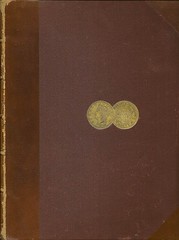
PREV ARTICLE
NEXT ARTICLE
FULL ISSUE
PREV FULL ISSUE
QUIZ ANSWER: MONTROVILLE W. DICKESONLast week I asked about Montroville W. Dickeson's connection to numismatics. Dave Hirt answered: He was the writer of the American Numismatical Manual. I have the 1860 edition in my library. His collection of coins was sold in several Birch sales, also several sales cataloged by Ebenezer Mason. The obsolete word "Numismatical" in the title is one clue to the unique nature of this book, one of the most important in U.S. numismatic history. Here's what Len Augsburger wrote about it in the Numismatic Bibliomania Society's compilation of The One Hundred Greatest Items Of United States Numismatic Literature. Pictured is the 1865 3rd edition from my library.
To read the complete entry on Dickeson's American Numismatical Manual, see: wiki.coinbooks.org/index.php/THE_AMERICAN_NUMISMATICAL_MANUAL
Ron Abler adds the following excerpt from his book on 1876 medals. Thanks!
-Editor
Dickeson's best known link to the Centennial was his Continental Dollar replica that he commissioned and sold as souvenirs at the Centennial Exhibition in Philadelphia. Less well known is his second contribution to the Exhibition. Based on the pioneering archaeological work that he had done from 1837 to 1844 studying the Indian burial mounds of the Mississippi River Valley, Dickeson commissioned a huge panorama of that expedition which was executed by John J. Egan, an itinerant Irish artist. Egan used the drawings and renderings of Dickeson as his source material. Panoramas were a popular attraction in the mid-nineteenth century. They were a precursor to the moving picture in which the painted canvas was unrolled a bit at a time to give the impression of traveling along the landscape. Dickeson's panorama was about eight feet high by 350 feet long and consisted of 27 scenes. It was unveiled at Memorial Hall (also known as the Art Gallery) at the Centennial Exhibition in 1876. It remained on display there until 1885. The Dickeson panorama is the only one that survives from that period, and it is now displayed at the City Art Museum in St. Louis, Missouri. Now, back to Centennial numismatics. Less is actually known for certain about Dickeson's Continental Dollar (diesinker, quantities, etc.) than his panorama, but the dies that he commissioned have a fascinating history. In February 2006, Jeff Shevlin, in the first issue of the So-Called Dollar Collectors' Club Journal, published a very thorough article on Dickeson's and subsequent restrikes of the Continental Dollar. I am indebted to him for much of the information here. After the Centennial, Dickeson's dies disappeared from view until about 1917 when Thomas Elder acquired them and used the obverse die to strike four of his medals. Then they disappear again until 1962 when Q. David Bowers, then of the Empire Coin Company, used both dies for 7,200 pieces in pewter (sometimes cataloged as white metal or tin). Then, later that same year, Robert Bashlow used the dies to strike copies in silver (2,000 pieces), goldine (3,000), and bronze (5,000). There are rumors of examples in aluminum and other off-metals, but I have not (yet) seen them myself. Here's where the story gets interesting. Bashlow announced publicly that after his use of the dies he would donate them to the Smithsonian, thus preventing any further copies ever being made. However, not as publicly, he first had working hubs made from the dies, which could be used to make additional dies. From these, he made at least two new sets of dies. For his silver copies he modified one of the reverse dies with the letter "S" at about 6:30 between the Delaware and Pennsylvania rings. One or both of the obverse dies and the "S" dies were then used to strike the silver copies. The other reverse die was used for the goldine and bronze versions. In 1964, yet another version of the dies was made with "6TH Boy Scout Jamboree '64"cut into the "FUGIO" ring of the obverse and the word "COPY" added directly above the Delaware ring on the reverse. I do not know if these were two new dies from the transfer hubs, or if the plain (no "S") reverse and/or one of the obverse dies from the goldine and bronze restrikes were used.
To read the earlier E-Sylum article, see:
MONTROVILLE W. DICKESON'S PANORAMA ON DISPLAY IN ST. LOUIS
(www.coinbooks.org/esylum_v15n28a31.html)
The Numismatic Bibliomania Society is a non-profit organization promoting numismatic literature. See our web site at coinbooks.org. To submit items for publication in The E-Sylum, write to the Editor at this address: whomren@gmail.com To subscribe go to: https://my.binhost.com/lists/listinfo/esylum All Rights Reserved. NBS Home Page Contact the NBS webmaster 
|
